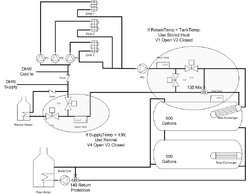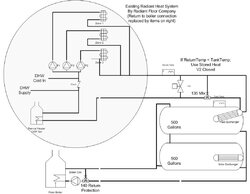Looking for comments. Last season I used the 2x500 storage tanks as a very big radiator in my unfinished basement. This helped the first floor a lot, but not so much for the second floor. I am now adding an in tank heat exchanger. The control logic will route the return water through the heat exchanger if the storage temp is greater than the floor return temp. Separate logic will bypass the Renai if the heat exchanger output is greater than 130F (because of the high head loss in the Rennai and to minimize wear and tear on the Rennai system). The radiant zones are controlled by a discrete radiant controller which starts the zone pump and the system circulator. Domestic Hot Water cold water make-up is run through the radiant tubes (to prevent stagnation in the floor during the summer) before being heated for domestic use (I know it is wierd, but it really does work well). I have omitted balancing valves, drains, vents, expansion, etc. for clarity (and time). Any comments or suggestions are appreciated.
In Tank Heat Exchanger and Rennai Backup
- Thread starter Hunderliggur
- Start date
-
Active since 1995, Hearth.com is THE place on the internet for free information and advice about wood stoves, pellet stoves and other energy saving equipment.
We strive to provide opinions, articles, discussions and history related to Hearth Products and in a more general sense, energy issues.
We promote the EFFICIENT, RESPONSIBLE, CLEAN and SAFE use of all fuels, whether renewable or fossil.



